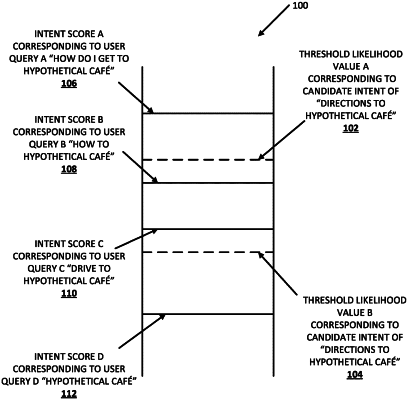| CPC G06F 16/3329 (2019.01) [G06F 16/3323 (2019.01); G06F 16/3344 (2019.01); G06F 16/337 (2019.01); G06N 20/00 (2019.01)] | 20 Claims |

|
1. A method implemented by one or more processors, the method comprising:
identifying a user query, generated by a user of an automated assistant client of a computing device;
processing the user query using a natural language understanding (NLU) model to generate (a) a candidate intent and (b) an intent score indicating the probability the candidate intent corresponds to the user query;
determining whether the intent score satisfies one or more conditions, wherein determining whether the intent score satisfies the one or more conditions includes determining whether the intent score satisfies a threshold likelihood value;
in response to determining the intent score satisfies the threshold likelihood value, causing the automated assistant client to perform one or more actions based on the candidate intent; and
in response to determining the intent score fails to satisfy the threshold likelihood value, and determining the intent score satisfies an additional threshold likelihood value, where the additional threshold likelihood value is less than the threshold likelihood value:
determining whether the candidate intent corresponds to the user query, wherein determining whether the candidate intent corresponds to the user query comprises:
causing rendering of output via the computing device, wherein the output includes a prompt, for the user, to determine whether the candidate intent corresponds to the user query,
receiving input, from the user, responsive to the output being rendered, and
determining, based on the input, that the candidate intent corresponds to the user query;
generating, in response to determining, based on the input that is responsive to the output that includes the prompt, that the candidate intent corresponds to the user query a mapping that is specific to the user and that is between an embedding space representation of the candidate intent and an embedding space representation of the user query; and
prior to retraining of the NLU model:
receiving an additional user query, generated by a user of the automated assistant of the computing device,
determining, based on the mapping that is specific to the user, whether the additional user query corresponds to the candidate intent, and
in response to determining, based on the mapping, that the candidate intent corresponds to the additional user query, causing the automated assistant to perform the one or more actions based on the candidate intent, and
causing, responsive to the NLU model being retrained, purging of the mapping between the embedding space representation of the candidate intent and the embedding space representation of the user query.
|